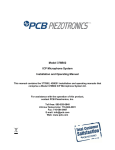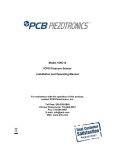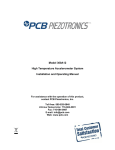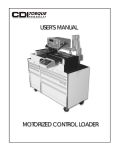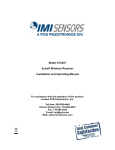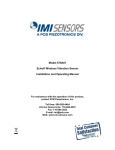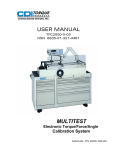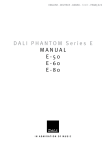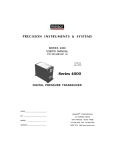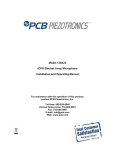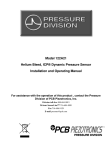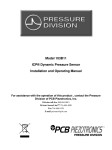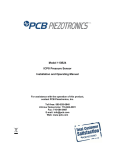Download Model 039030-50021 ROTARY TORQUE, W/AUTO ID Installation
Transcript
Model 039030-50021 ROTARY TORQUE, W/AUTO ID Installation and Operating Manual For assistance with the operation of this product, contact PCB Piezotronics, Inc. Toll-free: 800-828-8840 24-hour SensorLine: 716-684-0001 Fax: 716-684-0987 E-mail: [email protected] Web: www.pcb.com Warranty, Service, Repair, and Return Policies and Instructions The information contained in this document supersedes all similar information that may be found elsewhere in this manual. Total Customer Satisfaction – PCB Piezotronics guarantees Total Customer Satisfaction. If, at any time, for any reason, you are not completely satisfied with any PCB product, PCB will repair, replace, or exchange it at no charge. You may also choose to have your purchase price refunded in lieu of the repair, replacement, or exchange of the product. Service – Due to the sophisticated nature of the sensors and associated instrumentation provided by PCB Piezotronics, user servicing or repair is not recommended and, if attempted, may void the factory warranty. Routine maintenance, such as the cleaning of electrical connectors, housings, and mounting surfaces with solutions and techniques that will not harm the physical material of construction, is acceptable. Caution should be observed to insure that liquids are not permitted to migrate into devices that are not hermetically sealed. Such devices should only be wiped with a dampened cloth and never submerged or have liquids poured upon them. Repair – In the event that equipment becomes damaged or ceases to operate, arrangements should be made to return the equipment to PCB Piezotronics for repair. User servicing or repair is not recommended and, if attempted, may void the factory warranty. Calibration – Routine calibration of sensors and associated instrumentation is recommended as this helps build confidence in measurement accuracy and acquired data. Equipment calibration cycles are typically established by the users own quality regimen. When in doubt about a calibration cycle, a good “rule of thumb” is to recalibrate on an annual basis. It is also good practice to recalibrate after exposure to any severe temperature extreme, shock, load, or other environmental influence, or prior to any critical test. PCB Piezotronics maintains an ISO9001 certified metrology laboratory and offers calibration services, which are accredited by A2LA to ISO/IEC 17025, with full traceablility to N.I.S.T. In addition to the normally supplied calibration, special testing is also available, such as: sensitivity at elevated or cryogenic temperatures, phase response, extended high or low frequency response, extended range, leak testing, hydrostatic pressure testing, and others. For information on standard recalibration services or special testing, contact your local PCB Piezotronics distributor, sales representative, or factory customer service representative. Returning Equipment – Following these procedures will insure that your returned materials are handled in the most expedient manner. Before returning any equipment to PCB Piezotronics, contact your local distributor, sales representative, or factory customer service representative to obtain a Return Materials Authorization (RMA) Number. This RMA number should be clearly marked on the outside of all package(s) and on the packing list(s) accompanying the shipment. A detailed account of the nature of the problem(s) being experienced with the equipment should also be included inside the package(s) containing any returned materials. PCB for a complete statement of our warranty. Expendable items, such as batteries and mounting hardware, are not covered by warranty. Mechanical damage to equipment due to improper use is not covered by warranty. Electronic circuitry failure caused by the introduction of unregulated or improper excitation power or electrostatic discharge is not covered by warranty. A Purchase Order, included with the returned materials, will expedite the turn-around of serviced equipment. It is recommended to include authorization on the Purchase Order for PCB to proceed with any repairs, as long as they do not exceed 50% of the replacement cost of the returned item(s). PCB will provide a price quotation or replacement recommendation for any item whose repair costs would exceed 50% of replacement cost, or any item that is not economically feasible to repair. For routine calibration services, the Purchase Order should include authorization to proceed and return at current pricing, which can be obtained from a factory customer service representative. Contact Information – International customers should direct all inquiries to their local distributor or sales office. A complete list of distributors and offices can be found at www.pcb.com. Customers within the United States may contact their local sales representative or a factory customer service representative. A complete list of sales representatives can be found at www.pcb.com. Toll-free telephone numbers for a factory customer service representative, in the division responsible for this product, can be found on the title page at the front of this manual. Our ship to address and general contact numbers are: Warranty – All equipment and repair services provided by PCB Piezotronics, Inc. are covered by a limited warranty against defective material and workmanship for a period of one year from date of original purchase. Contact DOCUMENT NUMBER: 21354 DOCUMENT REVISION: B ECN: 17900 PCB Piezotronics, Inc. 3425 Walden Ave. Depew, NY 14043 USA Toll-free: (800) 828-8840 24-hour SensorLineSM: (716) 684-0001 Website: www.pcb.com E-mail: [email protected] Rotary Socket Wrench Torque Transducer Installation and Operating Manual For assistance with the operation of this product, contact: RS Technologies Division of PCB Load & Torque, Inc. Toll-Free in USA: 888-684-2894 24-hour SensorLineSM: 716-684-0001 Fax: 248-888-8266 E-mail: [email protected] 51678 RS Rotary Torque Transducer Manual_CE.doc 3/12/2012 ROTARY SOCKET WRENCH TORQUE TRANSDUCER OPERATION MANUAL 1.0 INTRODUCTION Rotary Socket Wrench Torque Transducers manufactured by RS Technologies Division of PCB Load & Torque, Inc., are widely used in the fastener assembly market to verify the performance of hand and power torque tools. These strain gage-based transducers are fitted on the output drive of a power tool and measure the torque applied by the tool to the fastener on an actual assembly. This measurement provides important information about tool shut off and can assist in establishing specifications for proper assembly. When equipped with the optional angle encoder, the rotary torque transducer can measure the angle of fastener rotation which is an important indication of joint integrity. Torqueangle transducers can provide the data to draw torque vs. time or torque vs. angle plots that can help analyze problematic joints and determine appropriate tightening strategies. They are also a key component of a threaded fastener torque tension testing machine. Rotary torque transducers come in a wide range of capacities (from ¼ Nm up to 25,000 Nm) and fit most popular drive sizes. All models utilize strain gages configured into a Wheatstone Bridge Circuit to produce the primary sensing element. The four-arm Wheatstone Bridge configuration is shown below in Figure 1. Also pictured in Figure 1 is the wiring code for the standard 10-pin PT receptacle. 2 to the deflection of the transducer and therefore the applied load. This configuration allows for temperature and pressure compensation, as well as cancellation of signals caused by forces not directly applied to the axis of the applied load. Output is typically expressed in units of millivolt per volt of excitation. Optional data collectors and signal conditioners are available from RS Technologies and PCB Load & Torque. There are two basic types of rotary socket wrench torque transducers: one measures torque and angle of rotation, the other measures only torque. They are both supplied with an Auto-ID chip that can be used by data collectors provided by RS Technologies to simplify setup and calibration. Specifications Torque Output at Rated Capacity … 2 mV/V ±0.25% FS Shunt Calibration … Matched 2.000mV/V ±0.25% with 43.575 kOhm precision resistor Interchangeability … Matched for mV/V and shunt calibration ±0.3% FS Nonlinearity … ±0.25% FS Hysteresis … ±0.25% FS Recommended Excitation … 10 VDC or AC RMS Bridge Resistance … 350 Ohms Compensated Temperature Range … +70to +150°F Useable Temp Range … 0 to +200°F General Receptacle … Bendix PT02H-12-10P Mating Connector … Bendix PT06A-12-10S(SR) Dimensions … Refer to Standard Torque Sensor Literature Angle Magnetic Encoder … 360 Poles (540 poles on 3/4-inch drives, 720 poles on 1-inch and 1 ½-inch drives, 900 poles on 2 ½-inch drives) Output … A-B Track 90 degrees phase difference flat over operating speed range Resolution w/Quadrature … ¼ degree (3/16 degree on 3/4-inch drives, 1/8 degree on 1-inch drives, 1/10 degree on 2 ½-inch drives) Output Voltage … High 5V, Low 0.5V Power Required … 5 VDC @ 120 mA max. Recommended Max RPM ¼-in Drive … 5000 3/8-in Drive … 2500 ½-inch Drive … 2500 ¾-in Drive … 2000 1-in Drive … 1000 1 ½-in Drive … 750 2 ½-in Drive … 500 Figure 1 – Rotary Socket Wrench Transducer Wheatstone Bridge & Wiring Code The gages are bonded to the transducer’s flexure. Typically, a regulated DC or AC excitation is applied between A and B of the bridge. When torque is applied to the transducer, the Wheatstone Bridge becomes unbalanced, producing an output signal voltage between C and D, which is proportional to the applied load. The magnitude of the output signal corresponds RS Technologies Division of PCB Load & Torque, Inc. Toll-Free in USA 888-684-28947 716-684-0001 www.pcbloadtorque.com ROTARY SOCKET WRENCH TORQUE TRANSDUCER OPERATION MANUAL Capacities The capacities of the torque-only transducers are listed in the table below. PART NO. DRIVE SIZE 039030-50002 039030-50021 039025-50051 039030-50101 039025-50101 039037-50022 039037-50051 039050-50101 039050-51201 039075-50301 039075-51501 039075-53601 039001-53102 039001-01302 039001-53033 039001-01103 039025-00183 ¼-inch Hex Drive ¼-inch Hex Drive ¼-inch Square Drive ¼-inch Hex Drive ¼-inch Square Drive ⅜-inch Square Drive ⅜-inch Square Drive ½-inch Square Drive ½-inch Square Drive ¾-inch Square Drive ¾-inch Square Drive ¾-inch Square Drive 1-inch Square Drive 1-inch Square Drive 1-inch Square Drive 1 ½-in Square Drive 2 ½-in Square Drive CAPACITY 32 oz-in 20 lb-in 50 lb-in 100 lb-in 100 lb-in 200 lb-in 50 lb-ft 100 lb-ft 148 lb-ft 300 lb-ft 368 lb-ft 600 lb-ft 1000 lb-ft 2213 lb-ft 3000 lb-ft 7350 lb-ft 18 000 lb-ft (0.23 Nm) (2.30 Nm) (5.65 Nm) (11.3 Nm) (11.3 Nm) (22.7 Nm) (67.8 Nm) (135.6 Nm) (200 Nm) (407 Nm) (500 Nm) (814 Nm) (1356 Nm) (3000 Nm) (4068 Nm) (10 000 Nm) (24 408 Nm) PART NO. DESCRIPTION ¼-inch Hex Drive ¼-inch Hex Drive ¼-inch Hex Drive ¼-inch Square Drive 3/8-inch Square Drive 3/8-inch Square Drive ½-inch Square Drive ½-inch Square Drive ¾-inch Square Drive ¾-inch Square Drive ¾-inch Square Drive 1-inch Square Drive 1-inch Square Drive 1-inch Square Drive 1 ½-in Square Drive 2 ½-in Square Drive CAPACITY 32 oz-in 20 lb-in 100 lb-in 100 lb-in 200 lb-in 50 lb-ft 100 lb-ft 148 lb-ft 300 lb-ft 368 lb-ft 600 lb-ft 1000 lb-ft 2213 lb-ft 3000 lb-ft 7360 lb-ft 18 000 lb-ft (0.23 Nm) (2.30 Nm) (11.3 Nm) (11.3 Nm) (22.7 Nm) (67.8 Nm) (135.6 Nm) (200 Nm) (407 Nm) (500 Nm) (814 Nm) (1356 Nm) (3000 Nm) (4068 Nm) (10 000 Nm) (24 408 Nm) RS Technologies Division of PCB Load & Torque, Inc. 2.0 SAFETY INFORMATION Applied loads must be limited to 100% of the rated capacity. Application of loads exceeding rated capacity can lead to damage of the transducer and potential injury to the operator. Therefore, always use care in applying torque to fasteners being audited or tightened failure. Always observe standard plant safety procedures for operation of pneumatic and electric power tools. Operators should always observe standard shop safety requirements, such as wearing steel-toed shoes, safety glasses, etc. 3.0 MECHANICAL INSTALLATION Mechanical installation consists of attaching the proper sized socket or drive fitting to the output end of the transducer. This socket or drive will be lined up with the fastener being tightened. The input end of the transducer is fitted onto the output drive of the tool. If using a torque-angle transducer, secure the housing so that it will not rotate during operation. NOTE: For square drive units, the input end is the female drive; the output end is the male square drive. For hex drive units, the input end is the male drive; the output end is the female hex drive. The capacities for the torque-angle transducers are listed below. 039230-50002 039230-50021 039230-50101 039225-50101 039237-50022 039237-50051 039250-50101 039250-51201 039275-50301 039275-51501 039275-53601 039201-53102 039201-01302 039201-53302 039301-01103 039625-00183 3 4.0 ELECTRICAL INSTALLATION The socket wrench torque transducer is connected to a data collector or signal conditioner via the 10-pin PT receptacle located on the top of the housing. Cable assemblies for RS Technologies and other instruments are available through RS Technologies Division of PCB Load & Torque, Inc. Connect one end of the cable to the transducer receptacle and the other end to the data collector/signal conditioner. Make sure to completely tighten the cable connector to both the transducer and the instrument. 5.0 POLARITY Clockwise torque on rotary torque transducers produces a positive-going signal output. Counterclockwise torque produces a negative-going signal output. Most data collectors provide a CW/CCW adjustment to ensure correct readings. Toll-Free in USA 888-684-2894 716-684-0001 www.pcbloadtorque.com ROTARY SOCKET WRENCH TORQUE TRANSDUCER OPERATION MANUAL 6.0 SHUNT CALIBRATION Shunt calibration is a practical method for providing field calibration of data collectors and strain gage transducers such as rotary socket wrench transducers. This provides assurance of obtaining accurate readings without having to apply known, traceable, physical input loads to the transducer, which may be impractical in an assembly line or out in the field. Shunt calibration simulates the mechanical input to a transducer by unbalancing the bridge with a fixed resistor placed across, or in parallel with, one leg of the bridge. For clockwise shunt calibration, or +CAL, the shunt resistor (RCAL) is shunted across the +Excitation (A) and +Signal (C) leg of the bridge. For counterclockwise shunt calibration, or –CAL, the shunt resistor (RCAL) is shunted across the -Excitation (BD) and +Signal (C) leg of the bridge. See Figure 1 for shunt resistor locations in the Wheatstone Bridge circuit utilized by rotary socket wrench torque transducers. The rotary socket wrench transducer provided by RS Technologies Division of PCB Load & Torque Inc. comes with a calibration certificate. On the first page of this certificate you will find a calibration value in engineering units that is associated with a resistor of a specified impedance. This resistor can be installed on the data collector and used when matching up the instrument to the transducer. Follow the instructions provided with the data collector for complete details on shunt calibration procedures. Typical Rotary Socket Wrench Transducer System Configurations Operation requires the connection of the transducer to a readout device, data collector, or signal conditioner. Readout instruments, data collectors, and suitable cable assemblies are available from RS Technologies Division of PCB Load & Torque, Inc. Operation with a Data Collector or Readout Device The span and zero of the instrument must be set before the rotary socket wrench transducer system can be used. The span can be set using the shunt calibration value and resistor supplied by the manufacturer, or by a deadweight torque calibrator. Refer to the shunt calibration information in the instruction manual of the instrument for proper setup information. Rotary Socket Wrench Transducer Operation Guidelines Rotary Socket Wrench Transducers are designed for use in measuring the torque output of electric and pneumatic fastener assembly tools. They are also used for threaded fastener testing and trouble-shooting. However, they have been used in many different rotating torque applications. The guidelines below provide some tips that will ensure proper operation and satisfactory results. • Although the ideal operating range for rotary torque transducers is 60 to 80% of rated capacity, the rotary socket wrench torque transducers can be used between 10 and 100% of rated capacity. This is largely because the first load point for a calibration is typically at the 10% mark but also that the output signal below 10% is often too low to provide adequate resolution by the readout instrument. • The rotary torque socket wrench transducer has an overload capability of 150% of rated capacity. This provides a safety margin in the event of an accidental overload. It is not recommended that the transducer be used to measure loads at or above 110% of rated capacity on a regular basis. • Keep the transducer in line with the axial orientation of the fastener. This will help to avoid side loads. Excessive side loads, such as those that may occur when testing large or heavy right-angle power tools, can cause inaccurate readings or even damage the transducer. • Ensure that both input and output drives of the transducer are fully engaged. Partial engagement may damage the transducer. • Hex drive transducers come with a spring loaded knurled ring that retracts to permit installation and removal of the Basic Shunt Calibration Procedure The following procedure outlines the basic routine of shunt calibration. The actual calibration procedure performed by your data collector may be automated and will differ. Consult the data collector instruction manual for further details. 1. 2. 3. 4. 5. 6. Connect the rotary socket wrench transducer to the data collector and allow adequate time for the system to stabilize. 2 to 5 minutes is recommended. With no load on the transducer, adjust the data collector zero controls for to read zero (0). Shunt the calibration resistor between the desired excitation and signal leads of the Wheatstone Bridge, as described in Section 6.0. Adjust the data collector’s gain or span controls as required to obtain an electrical output signal and/or numeric display that represents the simulated calibration load as indicated on the calibration certificate. Remove the shunt resistor and adjust the zero if necessary. If a significant zero adjustment is required, repeat Steps 25. 7.0 OPERATION RS Technologies Division of PCB Load & Torque, Inc. 4 Toll-Free in USA 888-684-2894 716-684-0001 www.pcbloadtorque.com ROTARY SOCKET WRENCH TORQUE TRANSDUCER OPERATION MANUAL drive bit. Make sure that both ends are fully engaged before use. • Damaged or Deformed Equipment Improper use When it’s necessary to use a drive adapter, use as few as possible to avoid side loads. • When using a transducer with an angle encoder, make sure that the housing is held secure to ensure best angle measurement accuracy. • Rotary socket wrench torque transducers are good for use with standard pneumatic tools, impulse tools, and electric power tools. Do NOT use with “impact” pneumatic tools. 8.0 TROUBLESHOOTING When having difficulty operating the rotary socket wrench transducer, refer to the following checklist. No output No power Loose or dirty connections Open circuit or short Faulty or improper wiring No torque applied Erratic or Improper Readings Excitation voltage drift Electrical noise Loose fixturing Open circuit or short Improper load applied Cable too long Blinking Display Overload condition Open circuit Zero Balance Load applied to transducer Overloaded or side-loaded transducer Open circuit Improper electrical connections Error Analysis PCB Load & Torque, Inc. typically supplies accuracy information on its products in the form of individual errors (see specification sheet). For rotary socket wrench transducers they are: Non-Linearity, Hysteresis, and Non-Repeatability. The customer can combine these individual errors to establish the maximum possible error for the measurement or just examine the applicable individual error. If the transducer is used for increasing torque measurement only, ignore the Hysteresis error. If the torque measurement is near the full rated capacity, the linearity error can be ignored. If the capability exists to correct the data through linearization-fit or a look-up-table, the error in the measurement can be minimized. A sophisticated user can get rid of all the errors except for the non-repeatability error in the measurement. If problems persist, contact PCB Load & Torque for technical assistance. 9.0 MAINTENANCE The rotary socket wrench transducers provided by RS Technologies Division of PCB Load & Torque Inc. are made of durable materials, and are intended for industrial use. However, routine maintenance, such as cleaning of electrical connectors, housings, and square drives with solutions and techniques that will not harm the physical material of construction is acceptable. The rotary socket wrench transducers should only be wiped with a damp cloth and never submerged or have liquids poured on them. NOTE: There are no user-serviceable components in rotary socket wrench torque transducers provided by RS Technologies division of PCB Load & Torque Inc. Removing the cover on the unit will void the warranty. ### Zero Shift Fixture preload Faulty or improper wiring Improper zero taken Zero Drift Unconditioned power supply Open circuit or short Loose wiring RFI/EMI interface Temperature change RS Technologies Division of PCB Load & Torque, Inc. 5 Toll-Free in USA 888-684-2894 716-684-0001 www.pcbloadtorque.com ROTARY SOCKET WRENCH TORQUE TRANSDUCER OPERATION MANUAL MANUAL NUMBER: 51678 MANUAL REVISION: NR ECN NUMBER: 38209 RS Technologies Division of PCB Load & Torque, Inc. Toll-Free in USA 888-684-2894 716-684-0001 www.pcbloadtorque.com 6 4 3 2 1 REVISIONS 45188 PCB Load & Torque Inc. claims proprietary rights in the information disclosed hereon. Neither it nor any reproduction thereof will be disclosed to others without the written consent of PCB Load and Torque Inc. REV DESCRIPTION ECO NR RELEASED TO DRAFTING 38678 D D 4.25 (.97) .98 C C 1.50 BENDIX RECEPTACLE PT02H-12-10P WIRING CODE: 9030 SERIES PIN A +POWER PIN B -POWER PIN C +SIGNAL PIN D -SIGNAL PIN E N/C PIN F N/C PIN G N/C PIN H N/C PIN J SENSE GRD PIN K SENSE +5V .90 1.25 1/4" HEX DRIVE (FEMALE) 9230 SERIES PIN A +POWER PIN B -POWER PIN C +SIGNAL PIN D -SIGNAL PIN E ENCODER GRD PIN F +5V PIN G CW LEAD PIN H CCW TRAIL PIN J SENSE GRD PIN K SENSE +5V Ø.65 1/4" HEX DRIVE (MALE) B B R.75 2.30 (.75) A A UNLESS OTHERWISE SPECIFIED TOLERANCES ARE: DIMENSIONS IN INCHES DECIMALS 4 3 XX ±.01 XXX ±.005 DIMENSIONS IN MILLIMETERS [ IN BRACKETS ] DECIMALS X ± 0.3 XX ± 0.13 ANGLES ` .5 DEGREES ANGLES ` .5 DEGREES FILLETS AND RADII .015 MAX FILLETS AND RADII 0.38 MAX 2 DRAWN PTE 3/22/12 CHECKED JAM 3/22/12 ENGINEER PTE TITLE OUTLINE DRAWING ROTARY TORQUE 1/4" HEX DRIVE, 10 PIN 2/28/12 24350 Indoplex Circle, Farmington Hills,MI 48335 (716) 684-0001 E-MAIL: [email protected] DWG. NO. 45188 SCALE: 1 FULL SHEET 1 OF 1










